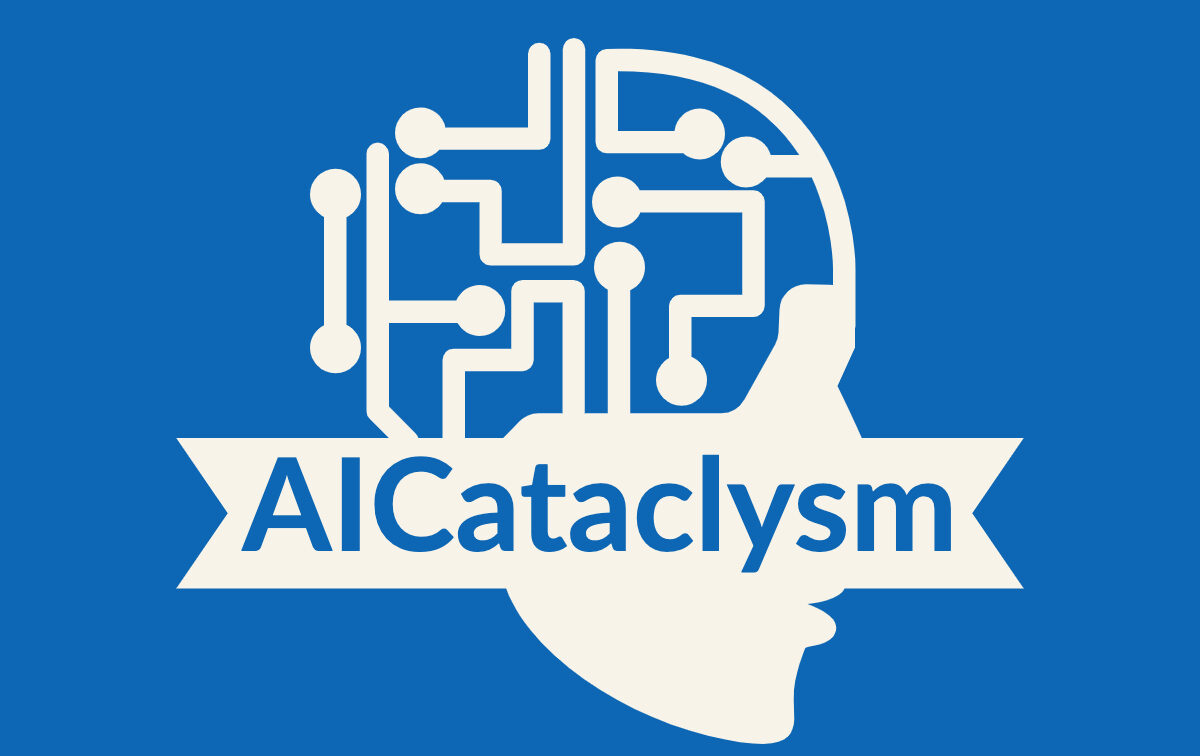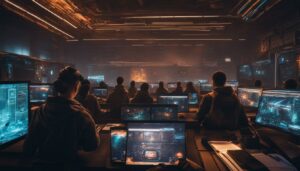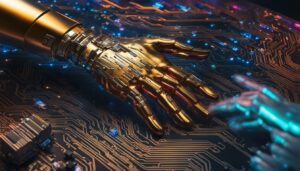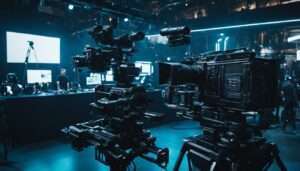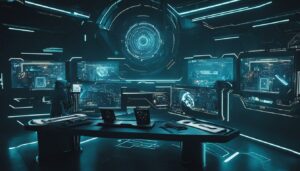Greetings! Today, I want to delve into the intriguing world of graphic design and the potential impact of artificial intelligence (AI) on this creative field. As technology continues to advance at an astonishing pace, it’s natural to wonder: Will AI replace graphic designers?
AI has already made its presence known in various industries, and graphic design is no exception. With AI technology in graphic design, designers can now leverage generative AI tools to assist with technical tasks and expedite the design process. This raises questions about the future of graphic designers and the role that AI will play in shaping the industry.
However, it’s important to acknowledge that AI has its limitations. While these tools can undoubtedly augment the design process, they might also pose a threat to artists’ intellectual property. Despite the advancements in AI, human creativity remains a vital and irreplaceable element in the design process.
In this article, we will explore the impact of AI on graphic designers and the ongoing debate surrounding AI’s role in the graphic design industry. We will discuss the advancements in AI technology, popular generative AI tools used in art and design, the problem of plagiarism, and the overall future of graphic designers in an AI-driven world.
Key Takeaways:
- AI technology is revolutionizing the graphic design industry, but it is unlikely to replace the need for human creativity.
- Generative AI tools are being used to create new images, texts, and shapes, but they have limitations and may infringe on intellectual property.
- Popular generative AI tools include Midjourney and DALL-E, offering unique features and capabilities.
- Plagiarism concerns have arisen due to AI’s reliance on existing work, raising questions about the authenticity of generated content.
- Graphic designers should embrace AI as a tool and focus on developing skills that AI cannot replicate, such as disruptive thinking and imaginative meandering.
What Is Generative AI?
Generative AI is a fascinating technology that utilizes algorithms to create new texts, shapes, and sounds by drawing from existing databases. It has gained significant attention in the art and design industries for its potential to disrupt traditional practices and spark new works and ideas. According to the World Economic Forum, generative AI can be used to generate various types of content, including advertisements, illustrations, and corporate visuals. This innovative technology enables designers and artists to explore new creative possibilities and push the boundaries of their craft.
By leveraging existing databases, generative AI tools can generate fresh content based on specific inputs or prompts. These inputs can range from a simple text description to more complex instructions. For example, an AI tool can generate a unique illustration based on a textual prompt such as “a garden with vibrant flowers and a flowing river.” The tool’s algorithm analyzes the prompt and produces a visual representation that aligns with the provided description.
Generative AI has the potential to disrupt the art and design industries by enabling the creation of new works and ideas. It empowers artists and designers to explore uncharted territories and experiment with novel concepts, ultimately transforming the creative process.
| Area of Application | Examples |
|---|---|
| Advertisements | AI-generated visuals for marketing campaigns |
| Illustrations | AI-generated artwork for books, magazines, and digital media |
| Corporate Visuals | AI-generated logos and branding materials |
| New Works and Ideas | AI-generated artistic creations and innovative designs |
Generative AI holds immense potential for the art and design industries. However, it is important to recognize that while AI tools can generate new content, they should be seen as aids to human creativity rather than replacements for it. The role of human designers and artists remains crucial in shaping and refining the outputs of generative AI tools. The fusion of human creativity and AI technology opens up exciting possibilities for innovation and artistic expression.
Popular Generative AI Tools in Art and Design
In the field of art and design, several generative AI tools have gained popularity for their ability to create stunning visuals from simple text prompts. Two notable examples of such tools are Midjourney and DALL-E, both of which have made significant contributions to the art and design community.
Midjourney: This generative AI tool focuses on creating gothic-fantasy-style images and award-winning scenescapes. It utilizes deep learning models trained on large open data sets of text and images to generate unique and captivating visuals. By simply providing a text prompt, users can unlock a world of artistic possibilities and explore the boundaries of their imagination. However, it is important to note that Midjourney is only available on the social media platform Discord and requires a subscription to access its full range of features.
DALL-E: Another popular generative AI tool in the art and design industry is DALL-E. Similar to Midjourney, DALL-E creates images from text prompts, but it also offers an outpainting capability, allowing users to expand the frame of an image. This tool has been praised for its ability to generate highly detailed and visually stunning visuals while maintaining a high level of fidelity to the original prompt.
| Generative AI Tools | Specialties | Availability |
|---|---|---|
| Midjourney | Gothic-fantasy-style images, award-winning scenescapes | Available on Discord, subscription required |
| DALL-E | Images from text prompts, outpainting capability | Availability details not specified |
These generative AI tools have opened up new possibilities for artists and designers, allowing them to explore uncharted territories and push the boundaries of their creative expression. However, it is important to acknowledge that these tools also have their limitations. While they can assist in generating impressive visuals, they are still dependent on the training data they were provided with, which may impose certain creativity limitations. Therefore, it is crucial for artists and designers to balance their use of generative AI tools with their own creativity and artistic vision to create truly innovative and unique works.
As the field of generative AI continues to evolve, we can expect to see more innovative tools and technologies emerge, further revolutionizing the art and design industries. These tools not only offer a new medium for creative expression but also provide artists and designers with new ways to explore and conceptualize their ideas. By embracing the possibilities offered by generative AI, artists and designers can continue to push the boundaries of their craft and create visually stunning works that captivate and inspire.
Other Generative AI Tools
In addition to Midjourney and DALL-E, there are other generative AI tools available in the field of graphic design. One notable tool is Google’s Imagen, which promises to deliver unprecedented photorealism in its generated images. However, it is important to note that Imagen is not yet available to the public.
Another generative AI tool worth mentioning is Stable Diffusion, which offers a unique feature that automatically improves prompts provided to the AI. This feature can be beneficial for designers who want to enhance the quality of the AI’s output and achieve more accurate and desirable results.
Furthermore, Adobe’s suite of generative AI tools provides designers with seamless design editing capabilities and workflow automation. This allows designers to streamline their design processes and optimize their productivity. Adobe’s tools are widely used in the industry and are known for their versatility and user-friendly interfaces.
| Generative AI Tool | Features |
|---|---|
| Google’s Imagen | Promises photorealism |
| Stable Diffusion | Automatic improvement of prompts |
| Adobe’s generative AI tools | Seamless design editing and workflow automation |
These generative AI tools offer various advantages for graphic designers, ranging from enhancing the quality of their output to improving their workflow efficiency. It is important for designers to explore and familiarize themselves with these tools to stay up-to-date with the latest advancements in the field and harness the power of AI in their design processes.
Problems With Plagiarism
The use of generative AI tools in design has sparked controversy surrounding the issue of plagiarism and intellectual property infringement. As these tools rely on existing work to generate new content, there are concerns about the potential for stolen ideas and the violation of artists’ rights. This has led to several lawsuits being filed against AI tool creators, highlighting the legal ramifications and ethical considerations in the use of AI in graphic design.
One of the key limitations of AI in this context is its reliance on pre-existing data sets. While these data sets may contain a wide variety of visual elements and artistic styles, there is always the risk of unintentionally reproducing someone else’s work. This raises questions about the originality and authenticity of the generated designs, as well as the potential impact on the livelihoods of artists and designers.
The controversy surrounding plagiarism and intellectual property infringement in the context of AI-generated designs highlights the need for clear guidelines and regulations in this rapidly evolving field. Designers and AI tool creators must navigate the fine line between utilizing AI technology to enhance creativity and innovation, while also respecting the rights and interests of original artists.
| Lawsuits | Concerns |
|---|---|
| Several lawsuits have been filed against AI tool creators for intellectual property infringement. | There are concerns about stolen work and the violation of artists’ rights. |
| Legal ramifications and ethical considerations of using AI in graphic design. | AI’s reliance on pre-existing data sets raises questions about originality and authenticity. |
| This controversy highlights the need for clear guidelines and regulations in the field of AI-generated designs. |
Will AI Replace Graphic Designers?
When it comes to the impact of AI on graphic design, there has been a lot of speculation about whether it will replace human designers altogether. However, the reality is that AI is unlikely to completely replace graphic designers. While AI can automate certain tasks and accelerate the design process, it cannot replicate human creativity and the unique perspectives that designers bring to their work.
Gunalan Nadarajan, a renowned professor and dean emeritus at the University of Michigan’s Stamps School of Art and Design, emphasizes the importance of teaching disruptive thinking and imaginative meandering in design education. According to Nadarajan, AI should be seen as another tool in an artist’s toolkit rather than a substitute for human creativity. Designers possess the ability to think outside the box, push boundaries, and infuse their work with personal expression, all of which are vital in the design process.
While AI can assist with automated tasks and streamline certain aspects of the design process, it is the human touch that truly sets designers apart. Designers have the ability to understand clients’ needs, interpret abstract concepts, and create visually compelling solutions that resonate with audiences. This level of human creativity and intuition cannot be replicated by AI. As the field of graphic design continues to evolve, designers should embrace AI as a tool that can enhance their work and productivity, while focusing on developing their unique human skills and pushing the boundaries of what is possible in design.
| Graphic Designers | AI’s Impact on Design | Human Creativity | Automated Tasks | Design Process |
|---|---|---|---|---|
| Designers bring creativity, intuition, and personal expression to their work. | AI can automate certain tasks and accelerate the design process. | Human creativity cannot be replicated by AI. | AI can assist with automated tasks in the design process. | Designers bring their unique perspectives and understanding to the design process. |
| Designers possess the ability to think outside the box and push boundaries. | AI is a tool that can enhance designers’ work and productivity. | Designers focus on developing their unique human skills. | AI can streamline certain aspects of the design process. | Designers create visually compelling solutions that resonate with audiences. |
Where AI Falters in Graphic Design
While AI tools have made significant strides in assisting graphic designers, there are certain areas where they still falter. One of the main limitations of AI in graphic design is its struggle with ambiguity. These tools often require clear and precise prompts to produce the desired output. Without specific guidance, AI may struggle to generate accurate or innovative designs.
Bias and stereotypes can also be perpetuated in AI-generated art due to the biases present in the data sets used for training. This raises concerns about the authenticity and inclusivity of AI-generated designs. Designers must carefully consider the data sets used and ensure that they are representative and diverse to avoid perpetuating bias.
Another limitation of AI in graphic design is the phenomenon known as hallucination. AI tools may occasionally produce inaccurate or illogical information, leading to designs that don’t align with the desired outcome. This highlights the importance of human judgment in reviewing and refining AI-generated designs.
Furthermore, while AI can assist with certain technical aspects of design, it may struggle with authentic discovery and creating truly innovative designs. Human imagination and decision-making remain crucial for pushing creative boundaries and developing unique visual solutions. AI tools should be seen as aids to the design process, complementing human creativity rather than replacing it.
| Limitations of AI in Graphic Design | Impact |
|---|---|
| Ambiguity | Requires clear and precise prompts for desired output |
| Bias and stereotypes | Can be perpetuated in AI-generated designs due to biased data sets |
| Hallucination | May produce inaccurate or illogical designs |
| Authentic discovery and innovation | AI may struggle to create truly innovative designs without human imagination |
What Design Students Should Know About an AI-Assisted Future
As AI technology continues to advance, it is important for design students to understand the implications and opportunities it presents in the field of graphic design. Incorporating AI into design education can help students develop the necessary skills to thrive in an AI-assisted future.
One key skill that design students should focus on is disruptive thinking. AI can assist with repetitive and technical tasks, allowing designers to explore more innovative ideas and concepts. By encouraging disruptive thinking, students can push the boundaries of design and create unique solutions that AI alone cannot achieve.
Another important skill for design students to develop is imaginative meandering. While AI can generate new images based on existing data, it cannot replicate the human imagination. Designers are often tasked with creating visuals that evoke emotions and tell stories. By nurturing their imaginative abilities, students can create designs that are meaningful and resonate with audiences.
The incorporation of AI technologies in teaching is also crucial. Design programs should introduce students to AI tools and techniques, allowing them to explore the possibilities and limitations of AI in graphic design. This hands-on experience can help students understand how to effectively collaborate with AI and leverage its capabilities to enhance their design process.
| Skills for an AI-Assisted Future | Importance in Design Education |
|---|---|
| Disruptive Thinking | Encourages innovation and pushes boundaries in design. |
| Imaginative Meandering | Enables the creation of visually compelling designs that evoke emotions and tell stories. |
| Incorporation of AI Technologies | Provides hands-on experience and prepares students for the AI-assisted future in graphic design. |
Art and design programs play a vital role in preparing students for an AI-assisted future. By equipping students with the necessary skills, encouraging disruptive thinking, and incorporating AI technologies into teaching, design education can empower students to thrive in a world where AI and human creativity work hand in hand.
Learning How to Prompt AI
When utilizing AI tools in graphic design, it is crucial to understand how to craft specific prompts that result in the desired outputs. Designers can enhance the output of AI by providing clear and precise prompts that focus on key design elements such as scale, space, and typography. The more specific the prompt, the more accurate and innovative the AI’s output is likely to be.
By learning how to effectively prompt AI, designers can harness the power of these tools to fuel their creative process. For example, when requesting a specific design request or concept, designers can experiment with different prompts to achieve the desired outcome. It is essential to understand that AI is a tool that can assist designers in their work, but it cannot replace the unique human skills and creativity that designers bring to the table.
In order to craft better prompts, designers should have a deep understanding of design principles and elements. This knowledge allows them to provide AI with the necessary guidance to generate accurate and innovative designs. Designers can further enhance their AI output by exploring different design styles and techniques, adapting them to their specific prompt criteria.
Understanding Design Elements
Designers should pay attention to various design elements such as color, composition, and typography when crafting prompts for AI. By incorporating specific design elements into their prompts, designers can guide AI to create visuals that align with their artistic vision. For example, a prompt that emphasizes a minimalistic design style might include specific instructions for clean lines, negative space, and a limited color palette.
In addition to design elements, designers should also consider the context in which their work will be presented. Prompts can be tailored to specific mediums or platforms, such as social media posts or print advertisements. By providing AI with specific instructions related to the intended medium, designers can ensure that the generated designs are optimized for the desired context.
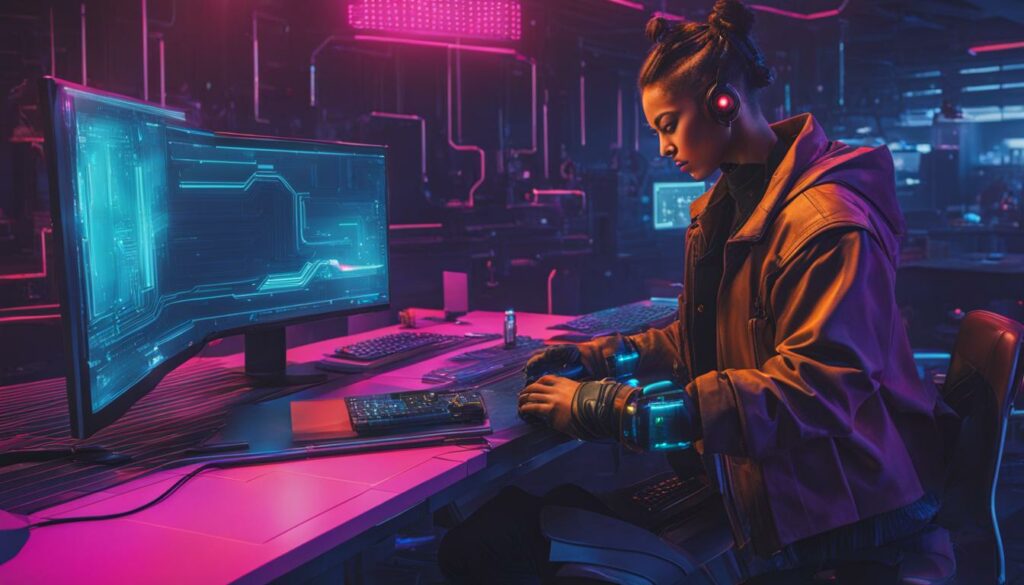
Enhancing AI Output
Designers can enhance the output of AI by carefully evaluating the results and iterating on the prompts. By analyzing the generated designs, designers can identify areas for improvement and refine their prompts accordingly. This iterative process allows designers to fine-tune the AI’s output and achieve the desired design outcome.
Furthermore, designers can also explore the possibility of combining AI-generated elements with their own creative input. By leveraging the strengths of AI and their own unique skills, designers can create truly innovative and captivating designs. This collaborative approach allows designers to push the boundaries of what is possible and deliver exceptional results.
Specific Design Requests
When designers have specific design requests, such as creating a logo or a specific illustration style, AI can be a valuable tool. By providing detailed prompts that outline the specific requirements and desired aesthetic, designers can leverage AI to generate initial design concepts. These concepts can then be further refined and customized by the designer to achieve the desired result.
Overall, learning how to prompt AI effectively empowers designers to harness the potential of AI tools in graphic design. By understanding design elements, crafting better prompts, and enhancing the AI’s output, designers can leverage AI as a powerful tool in their creative process.
AI’s Impact on Graphic Design Careers
As artificial intelligence (AI) continues to evolve, its impact on graphic design careers is a topic of great interest and concern. Designers need to adapt to this changing landscape by learning new skills, staying on top of trends, and embracing the possibilities that AI offers. In this section, we will explore the various ways in which AI is influencing the future of graphic design careers.
- Learning New Skills: To thrive in an AI-assisted world, graphic designers should consider expanding their skillsets. This might involve learning coding languages commonly used in AI development or familiarizing themselves with AI design tools and software. By acquiring these skills, designers can complement their creative abilities with the technical knowledge necessary to work alongside AI technologies.
- Creativity Development: While AI can assist with certain design tasks, creativity remains a uniquely human trait that cannot be replicated by machines. Designers should focus on nurturing their creative thinking and problem-solving skills, as these are areas where AI currently falls short. By continuously developing their creative abilities, designers can offer unique perspectives and innovative solutions that set them apart in an AI-driven industry.
- Staying on Top of Trends: The field of AI is constantly evolving, and designers must stay informed about the latest advancements and trends. By keeping up with AI developments in graphic design, designers can identify new opportunities to incorporate AI tools into their work and stay ahead of the curve. Being aware of emerging AI technologies ensures that designers remain relevant in a rapidly changing industry.
- Starting a Business: The rise of AI in graphic design opens up new entrepreneurial possibilities. Designers can leverage AI tools to streamline their workflows, automate repetitive tasks, and offer innovative design solutions to clients. By embracing AI and combining it with their unique design skills, designers can establish their own businesses and create new opportunities in the AI-assisted design landscape.
It is important for graphic designers to recognize that AI is not a replacement for their skills and expertise. Instead, AI should be seen as a tool that can enhance and augment their creative abilities. By embracing AI technologies, staying adaptable, and continuously developing their skills, designers can navigate the impact of AI on their careers and shape the future of graphic design.
| AI’s Impact on Graphic Design Careers | Key Points |
|---|---|
| Learning New Skills | Designers need to acquire technical skills, such as coding, to work alongside AI technologies. |
| Creativity Development | Designers should focus on nurturing their creative thinking and problem-solving skills, which cannot be replicated by AI. |
| Staying on Top of Trends | Designers should stay informed about the latest AI developments in graphic design to remain relevant and identify new opportunities. |
| Starting a Business | Affordable AI tools can help designers automate tasks and offer innovative design solutions, enabling them to start their own businesses. |
Conclusion
In conclusion, AI is revolutionizing the field of graphic design, but it is unlikely to replace graphic designers entirely. While AI tools can assist designers with technical tasks and accelerate the design process, human creativity and skills remain crucial in the design industry.
The future of graphic designers with AI will involve finding a balance between the capabilities of AI technology and the unique qualities that humans bring to the table. AI should be seen as a powerful tool that can aid designers in their creative process, rather than a replacement for their creative work.
As AI continues to advance, it is important for designers to adapt and continue developing their human skills. Designers should focus on honing their disruptive thinking, imaginative meandering, and innovation abilities, as these are skills that AI cannot replicate.
Ultimately, the continued importance of human skills in design cannot be understated. While AI can assist in generating designs and automating certain tasks, it is the human touch that adds the personal and emotional elements to design that cannot be replicated by AI alone. By embracing AI technology and leveraging their unique human skills, graphic designers can shape the future of the industry and create innovative and impactful designs.
FAQ
Will AI replace graphic designers?
No, AI will not replace graphic designers entirely. Human creativity and skills are essential in the design process, and AI tools should be seen as aids rather than substitutes.
What is generative AI?
Generative AI is an AI tool that uses algorithms to produce new texts, shapes, and sounds by drawing from existing databases. It has the potential to disrupt the art and design industries by helping humans generate new works and ideas.
What are some popular generative AI tools in art and design?
Some popular generative AI tools in art and design include Midjourney and DALL-E. Midjourney creates images from text prompts, known for its gothic-fantasy-style images and award-winning scenescapes. DALL-E also creates images from text prompts and has an outpainting capability to expand the frame of an image.
Are there other generative AI tools available?
Yes, there are other generative AI tools available. Google’s Imagen promises unprecedented photorealism, Stable Diffusion offers a feature that automatically improves prompts, and Adobe’s suite of generative AI tools allows for seamless design editing and workflow automation.
Are there any concerns about using AI tools in graphic design?
Yes, there are concerns about plagiarism and intellectual property infringement when using AI tools in graphic design. Some artists and designers have expressed negative sentiment towards these tools, as they rely on existing work to create new content.
Will AI be able to replace graphic designers entirely?
No, AI is unlikely to replace graphic designers entirely. While AI tools can assist with certain tasks, human creativity and skills are still essential in the design process.
Where does AI falter in graphic design?
AI can struggle with ambiguity, bias, perpetuation of stereotypes, and hallucination. It may also struggle with authentic discovery and creating innovative designs, as human imagination and decision-making are crucial for true innovation.
What should design students know about an AI-assisted future?
Design students should be aware of the growing role of AI in graphic design and develop relevant skills. Art and design schools should teach disruptive thinking, imaginative meandering, and other human abilities that AI cannot replicate.
How can designers effectively prompt AI?
Designers should learn how to craft specific prompts that result in desired outputs. Understanding design elements like scale, space, and typography can help designers create better prompts.
What is the impact of AI on graphic design careers?
The impact of AI on graphic design careers is still uncertain. However, designers can prepare themselves by learning new skills, staying on top of AI trends, and incorporating AI tools into their work.
